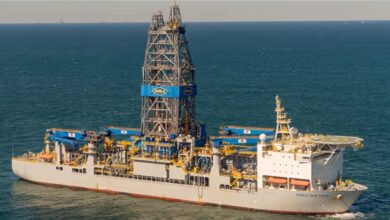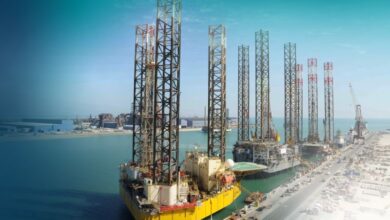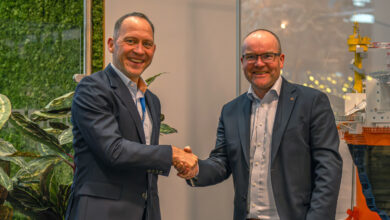Increasing complexity, global expansion calls for crew competence
Industry steps up efforts to take ownership of competence assurance
By Joanne Liou, associate editor
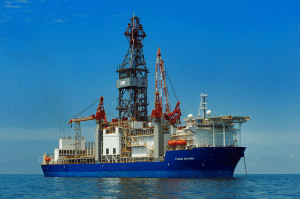
The nature of the oil and gas industry is often described as cyclical. Personnel shortages accelerated by the Big Crew Change and market upswing reflect challenges experienced in the 1980s. However, compared with 30 years ago, today’s challenges are further compounded by the industry’s global expansion and an increased emphasis – both internally within the industry and from government and public stakeholders – on ensuring competency. As part of industry’s efforts to drive down the number and severity of incidents, attention is focused more sharply on verifying crew competency to complete the job correctly and safely the first time. “If we don’t have people and equipment with sufficient competency and integrity to do the job safely, we won’t do it,” Jim Barron, manager of Chevron’s Clear Leader Center, said. “Unless we can build that competency within our own personnel and be confident the contractors we’re engaging also have it, we’re not going to be able to do what we need to do, and the entire industry is going to suffer.”
Competence assurance programs are not new to the industry, but interest in them, as well as the number of companies willing to invest in them, have increased significantly over the past three years. The IADC Competence Assurance Accreditation (CAA) program, established in 2007, used to receive one to two applications every year but now sees seven to nine applications per quarter, Dr Brenda Kelly, IADC senior director of program development, explained. “More people are asking; more people are talking about it in committees… It’s grown exponentially in participation.” Fourteen companies have received CAA accreditation for as many as 63 specified positions. Noble Drilling, Transocean and Nabors have pending applications. The accreditation is designed to assure programs meet industry-accepted practices to develop and ensure the skills of personnel.
The CAA is just one among several initiatives IADC is undertaking in the competency realm. The association kicked off the KSA project last year and in August 2013 launched the Well Control Institute and the Workforce Attraction and Development Initiative (see Pages 18 and 20).
Competence assurance has been on the tip of industry’s tongue at conferences and meetings around the world. Efforts vary, with some companies just beginning to formalize their competence assurance process and others with programs that go back much longer. Diamond Offshore Drilling, for example, has had a competency program in place for nearly 10 years. “We’re defining (competency assurance) as necessary skills, core skills of each position that are universal throughout industry that are common to each rig position around the world,” A.J. Guiteau, the company’s director for learning & development, said. Diamond Offshore received IADC’s CAA accreditation for its competency assurance program earlier this year.
Alongside drilling contractors and operators, service companies and training companies also are realizing the effects of competency assurance. In addition to Chevron and Diamond Offshore, Vantage Drilling, National Oilwell Varco (NOV) and PetroSkills share with Drilling Contractor their experience and efforts toward competency.
Defining competence assurance
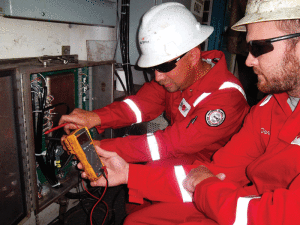
Industry leaders agree that competency assurance is not administering a written test that employees have to pass; rather, it is an ongoing process that ensures a person has the necessary skills to complete a job properly. Mr Barron described it as providing “objective quality evidence” of an employee’s or contractor’s knowledge and skills “by somebody who is a recognized authority and has the experience to judge competency levels. (The authority) can then attest somebody has demonstrated those skills, does know how to do this and does know how to apply our own internal standards and industry best practices.”
IADC defines competency assurance as a process, in effect a management system, by which companies have procedures in place to define competencies for specific job positions and assess employees against those defined competency standards. Defined competencies must be updated to reflect changes in operations with new technologies and equipment, and individual employee competencies must be monitored and reviewed to ensure continuity. This can be a challenge in today’s rapidly evolving industry. “The industry is changing so fast with new types of drilling equipment, new depths, which presents new hazards,” Chad Crain, training manager for Vantage Drilling, said. “It seems the minute you write content, it’s obsolete or there is a new standard.”
However, companies are realizing that competency assurance is a must in order to ensure operational integrity and to catalyze performance improvements. Just as time and resources must be devoted to ensure equipment will perform as expected, time and resources also must be invested to ensure employees will perform as expected. At Diamond Offshore, employees must pass an HSE training assessment after an initial safety orientation and training before they’re allowed to step foot on the rig. “No employee can work any position or complete any formal training requirements until he completes this formal safety orientation and training,” Mr Guiteau said. Further, each time a person moves from one position to another or receives a promotion, the HSE training and safety assessment must be completed again as the safety responsibilities are refocused to each level of job requirements.
Upon completion of that entry-level safety training and assessment, the rig-site training of the employee begins with his or her supervisor in the position requirements laid out in the competency document. As this process continues through a six-month period, the employee must also complete formal shore-based training that is specified by a regional competency training matrix. Once all training and assessments are completed, the employee is considered fully competent within his or her position. “This entire process follows the employee wherever he or she is within the company and is electronically monitored no matter where assigned,” Mr Guiteau explained.
Value of competency, cost of incompetency
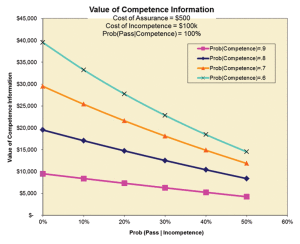
Compared with the 1980s oil boom, the complexity of the modern drilling landscape has raised the stakes – both rewards and risks – much higher.
Attitudes and expectations have both shifted in a tougher regulatory environment and in the face of much higher operating costs. “Thirty years ago, most people learned from their mistakes on the job,” Mr Barron explained. “Our attitude toward learning from mistakes has changed, and we are now focused on making sure the learning takes place before people are placed in a position where mistakes could have serious consequences. We are committed to completing every task the right way, every time, and if a task cannot be done safely, it will not be done. In addition, because of the size and complexity of many of our projects, even small mistakes can be technically challenging and very costly to correct.”
Beyond these drivers, the financial benefits of competency are becoming more apparent, as well. Companies are realizing that the cost of establishing a competence assurance program is ultimately far lower than the cost of incompetency. “Ensuring competency is the right thing to do. It makes sense, and regulation drives it,” Dr Kelly said. “But on top of that, now with some competency programs established long enough, we’re starting to see that there’s a financial gain. When you reduce the number of incidents, you reduce the financial cost of injuries, repairs and recoveries.”
Especially for companies like drilling contractors, it’s their people and their equipment that distinguish one company from another, Ford Brett, CEO of PetroSkills, said. Companies will invest money and time to ensure the integrity of drill pipe, for example, that it will do what it was made to do. “What can go wrong when drill pipe fails is expensive, but when people fail, we can have even more expensive problems.” The issue then becomes a matter of determining the amount of resources that should be spent on ensuring competency, he said.
Calculating competency
Within the past year, Mr Brett continued, operators have started to use a method called the Bayesian analysis to quantify the economic value of competency assurance and the amount of resources that should be put toward competency. The technique compares the cost of incompetence with the probability of incompetence and with the cost and effectiveness of the assurance activity. This allows operators to prioritize and properly resource their competency management activities. The analysis is mathematically the same as a technique that many operators have been using for the past 10 to 15 years to improve their exploration efficiencies, he explained.
PetroSkills works with operators using the Bayesian technique, and Mr Brett notes a trend of companies finding opportunities for performance improvement via more rigorous competency assurance. “There are mathematical techniques to allow you to understand how much money you should spend assuring the competence of people, and it depends on the cost of incompetence, which is what would be the cost of not doing it right and how certain you are of the average person’s capabilities. Money spent assuring competence can be valued just like insurance,” Mr Brett said. The ratio of investment in assurance to cost of incompetence can be more than 10 times, he added. “As an industry, we generally drastically underinvest in competency assurance.”
The numbers used in the Bayesian equation are statistical and based on, for example, the probability of an employee being able to diagnose and repair a piece of equipment. “How often do we do it properly, and how often does the average person not do it properly?” Mr Brett explained. “What is the cost of the downtime?”
The next step is to determine how much money it would be worth to ensure competence – taking into account how much money it would cost for a specific assurance activity and how much money it would cost if equipment is not diagnosed and repaired properly.
The effectiveness of that assurance activity should also be factored in. “If it was an extremely expensive simulator that didn’t really duplicate performance very well, then that would not be worth it,” he said. On the other hand, “if it was a cost of a technical mentor watching how people work and making suggestions, it might cost very little money and it might be very accurate, in which case it would be worth doing.”
Basically, the Bayesian technique provides companies with an economic value in dollars and cents on how development and assurance programs should be run.
Developing a competence program
Drilling contractors, operators and service companies alike agree that, in order to have a successful competency assurance program, there must be clearly defined business goals. Recognizing that the industry will effectively double the current population of its workforce within five to eight years, Chevron is taking a structured approach to its competency assurance program, Mr Barron explained.
For Chevron’s drilling and completions unit, the effort to establish a competency assurance program has been ongoing within the past couple of years and to date has centered around Chevron’s in-house, IADC-accredited WellCAP and WellCAP Plus well control training programs. In addition, Chevron is building tools to define the specific technical and leadership skills needed to determine competency for specific positions – including drilling engineers, completions engineers, subsea well intervention engineers, drill site managers and well site managers – and what different levels of competency mean for each of those skills. “The assurance piece is going to be a review of the actual work produced,” he said. “It’s not going to be just passing a test or ticking a box. It’s going to be rigorous to give us the confidence that we have qualified people in critical roles who know what they’re doing.”
One of the biggest challenges is the shortage of people to assist the effort, a challenge that Chevron, as well as many other companies, are facing as they implement their competence assurance programs. “You need people who have the technical knowledge to be able to assess people who are being examined, and Chevron is committed to placing highly qualified employees in these roles,” Mr Barron said. “So to make those people available to do that, you have to be willing to take them out of other jobs where their skills are also in high demand.”
The company is working on tools and processes to streamline the amount of time and effort a potential assessor would take out of their regular job to do an assurance. “We are also reviewing the question of whether assessments are better done by a smaller number of people devoting a larger percentage of their time or a larger number of people devoting a smaller percentage of their time. Factors we have to consider include an individual’s degree of interest in doing assessments, how well they do it and the breadth of skills they are qualified to assess.” In the tug of war between what’s urgent now versus what’s important in the long term, Mr Barron said, “you have to come down on the side of developing and ensuring competency in these roles for the long-term benefit of all concerned.”
Since Vantage Drilling launched its competency assurance program, CARE, on the Titanium Explorer drillship in the Gulf of Mexico in December 2012, the company has added an onsite assessor to the process. Having an outside pair of eyes on the rig to view operations helps the company realize opportunities to improve, Mr Crain explained. Under CARE, drillers and assistant drillers must complete an offshore competency assessment that includes five components: driller 101, a professional discussion, a written exam, well control overview with BSEE requirements and an on-the-job assessment.
Driller 101 is a one-on-one discussion between the employee and the assessor to review the basics of drilling and well control. In the professional discussion, the employee’s roles and responsibilities as a drill crew supervisor are discussed with the assessor. Employees are quizzed on their use of “soft skills” when dealing with the people under their supervision. The written exam tests general knowledge, as well as well control, through scenario-based questions. The test is conducted at the beginning of the assessment process to give the assessor a baseline of the candidate’s knowledge and is conducted as part of the written exam.
“We reserve a number of questions that cover specific BSEE requirements and our Subpart O plan (well control and production safety training requirements for operation in the Outer Continental Shelf),” Mr Crain told Drilling Contractor. “We have modeled the questions to mimic the questions on the BSEE well control test.”
A third-party verifier will be used to review and confirm the assessments and construct a development plan for each individual. The goal is to identify ways to advance and improve performance. The training department is then responsible for following up on assessments and ensuring that gaps noted in the assessment are being addressed.

At NOV, the company designed the development stages of its competence management system with flexibility in mind. For an individual that comes into a particular role at NOV, the training or the experience that a person needs to go through to become competent is first identified, Grant Almond, vice president of educational services at NOV, explained. This can be modified based on the individual’s experience level. “Having a flexible program, one that can adapt and evolve with the changing business needs of the company, is key to the success of this program.”
He added that it’s also important to establish a clear objective for the competency program. “Have a clear picture of what your end result should be,” he advised. “You really have to understand your own business, what your needs are and then define what you want the outcome to be. Once you understand what your outcome should be, then it’s very easy to craft a system that will get you to that outcome.”
NOV’s competency assurance program, which has been in place since late 2006, was first implemented in Rig Solutions, its drilling equipment group. Looking at its technical skilled areas, the company saw the need to have more formalized programs to develop personnel skills, quantify their skill levels and support the onboarding and training of new-hires. The program has expanded in the last two years into manufacturing and other operations, as well; it now incorporates roughly half of NOV’s 62,000-plus personnel globally. Specific positions in the program include field engineers, test and quality engineers, repair machining and assembly personnel in manufacturing, along with project management.
Working with counterparts
Competence assurance programs are not just internal programs. Mr Almond said that NOV has increased interaction over the past couple of years with its customers to help them understand how NOV ensures employee competence. This has been driven by customers wanting to know “what we’re doing, how we’re doing it, what the overhead is – how much management does it take, how much time does it take and how much investment,” Mr Almond said. Companies are not just looking at the quality of their vendors’ organizations but also looking for best practices start their own programs. “The key element to remember is that we are all working on this together. We want everybody to be successful in competency because it has a positive effect on the industry we are all working in.”
When Vantage Drilling conceived and drafted its CARE program, the company worked with Petrobras to ensure expectations would be met during the program’s rollout on the Titanium Explorer; the rig is under an eight-year contract to the Brazilian operator. “Petrobras was very involved, not so much in the drafting of the program but with support during the rollout onboard the rig,” Mr Crain stated.
Vantage Drilling plans to expand the program next year to its Tungsten Explorer newbuild drillship in West Africa and its Platinum Explorer ultra-deepwater drillship in India under a five-year contract to ONGC. For both rigs, the contractor plans to engage the operators early to ensure the program addresses region-specific challenges. “Anytime we’re going to roll out a type of system that is going to affect all facets of operations on the rig, we will take the program to our clients prior to launch and get their feedback and make sure they have a clear understanding of the purpose of the program and what results we expect to see,” Mr Crain said.
Bringing a common voice to help demonstrate what industry is doing, IADC is working with companies from all sectors of industry to facilitate alignment of competency goals and to give regulators and the public confidence that the industry has control of what it is set out to do. “IADC’s objective is to support industry in its goals,” Dr Kelly said, “and this is an area where our industry is being tested and tried and pushed on multiple fronts. The need for uniformity is global – global in our language, global in our way of thinking, global in our view of what a competence program looks like.”
The value of IADC’s accreditation system for competence assurance programs is the consistency it brings to all the parties – drilling contractors, operators and service companies. “The job positions at each of those companies and the competencies required are very different. However, IADC accreditation helps to ensure that there’s a uniformity in the process they’re applying to assure competence,” Dr Kelly stated. “Accreditation gives you confidence that a company is managing its program according to an industry-accepted set of standards.”
IADC’s accreditation program also goes beyond verifying that a competence assurance program is in place; it verifies the program is performing well and is being monitored on an ongoing basis. The requirement for quality assurance processes assures companies are monitoring and measuring their company’s performance and seeking continuous improvement of their processes. Through key performance indicators, such as number of employees assessed as competent, frequency of employee’s reassessment, etc, the continuity of the program and continuous improvement are assured.
Initially, the program focused on drilling contractors and the competencies tied to specific positions. Since then, IADC has expanded the program to permit defining of competencies by tasks, not just by position. “We modified the program to incorporate a systems approach to define competencies so the program would be equally fitting to service and other types of companies, including operators, who have employees in unique roles with individually unique sets of competencies.” In the systems approach, a company defines all role/task competencies and must create a composite list of competencies for each employee based on the individual’s role within the company.
Ongoing development
Diamond Offshore recently received IADC accreditation for its competency program, which has been in place since 2002. Rig employees are automatically placed in the program based on 33 formal positions, each containing two to three levels for advancement. Each position has a listing of the formal core knowledge, skills and abilities that must be demonstrated to the employee’s supervisor in accordance with guidance statements that specify how the work must be done. “Successful completion of your competency assurance assessments in every position you hold absolutely dictates how your career goes working offshore at Diamond Offshore,” Mr Guiteau stated. Advancements and promotions cannot be triggered within the company without this process being completed and approved for each employee. “This platform allows for employees to follow a performance guideline that provides pathways for their career.”
The company updates the competency assurance program daily through the management-of-change process to reflect new fleet integrity assurance procedures, changes in equipment and new requirements from regulations and benchmarking industry practice. The program will undergo major upgrades upon the completion of the IADC KSA project this year.
“The guidelines set out by IADC will help to define the core elements of competency for most drilling positions around the world,” Mr Guiteau said. “It will be a big step forward when we have an industry- and globally accepted set of standard competencies.” Companies representing drilling contractors, operators and service companies – Diamond, Pacific Drilling, Ensco, Latshaw Drilling, Chevron, BP, Schlumberger, among many more – have been active in the KSA upgrade project.
The IADC KSA project is on pace for completion by the end of this year, with a goal of completing competencies for 73 rig-based positions. Eight workgroups have been assembled to work on the project: Drilling Onshore, Drilling Offshore, Subsea Operations, Marine Operations, Technical Maintenance, QHSE/Process and Procedures, Facility Management and Regulatory. Participants have submitted and reviewed competency line items and identified each competency as “core” or “additional” based on each position.
With regard to the US SEMS regulations that look for systems assuring competency, Mr Guiteau sees further development in the form of reassessments – how to reassess and how to maintain the quality of an individual’s work. “That’s a big discussion going on right now in the industry,” he said, on whether companies should address everything in the employees’ competency assessment document or address only the top core elements that are safety related.
He believes performance appraisals and feedback to the employee will become more formalized – not by re-documenting the competency document but by periodically giving employees specific performance feedback in a structured way from their supervisors. This feedback may trigger retraining and reassessment. “Good performance appraisals addressing areas for improvement in competency job expectations could help employees maintain competency levels,” Mr Guiteau told Drilling Contractor. “Tying performance feedback to competency expectations is becoming an industry discussion. This feedback could take many forms, from yearly formal appraisals to short periodic ‘work performance report cards.’ ”
Measuring effectiveness
To measure the effectiveness of a competence assurance program, leading indicators, such as the number of employees who are qualified to fill certain positions, can help. “At the end of the day, it’s going to be whether you are able to accomplish what you say you’re able to do and if you have the people to do it,” Chevron’s Mr Barron said. Monitoring the number of people who are attending training is one way of quantifying program effectiveness, while another is counting the number of people who have quality development plans in place based on “our ‘SMART’ criteria – Specific, Measurable, Attainable, Relevant and Time-bound. How well those development plans are executed is also an early indicator we are monitoring.”
Although Vantage Drilling’s CARE program has been in effect for less than one year, Mr Crain said, he has already seen positive, if preliminary, results. Operational integrity and equipment reliability have both been positively impacted by the assurance of competence, as crews are able to identify potential problems before they can lead to downtime. “Our efficiency on the rig has gone up since implementation, and we’ve seen steady gains in the uptime of the rig,” he said. Uptime for the Titanium Explorer reached 99% in June and 100% in July, according to Vantage.
“The training that we require as part of the competency system and the overall OJT (on-the-job training) process helps reduce downtime because the operations crews are recognizing the problem before it becomes an incident and relaying that information to the maintenance crews.”
Diamond Offshore also monitors the number of people who have been promoted during the year through its competency program and counts the number of people who are training in advance of their positions. Typically, an employee who is motivated or has proven themselves to be interested and able to do the next level of work will train onboard the rig using the competency guidance document for the next level. Once that individual has proven competence in core skills for the higher level, he or she is placed in a pool to be considered for promotion. “Generally we have somewhere around 15% of our workforce always working in advance to their next positions,” Mr Guiteau said.
For some companies, metrics such as the amount of scrap generated can help to measure improvements in the manufacturing process. “A machinist that improves his skills will increase efficiency and reduce scrap,” Mr Almond explained. “This can also be done by improved processes created by people that have also improved their own skills and competencies.”
With the goal of constant improvement, NOV evaluates a survey and report that is generated for each project as part of the job assignment and completion process. “It’s basically two-fold – what the individual is saying he did and what the customer is saying about the job and the individual,” Mr Almond explained. Through regular assessments of individual competencies, the company identifies skills or qualifications needed to be successful. “We look at all information available, both historical and current, to enhance the process of developing competency in a given area.”
Fresh pools of talent
As personnel needs in the oil and gas industry expand, companies are looking outside its own industry to tap human resources with transferable skills.
For the past three years, Chevron has been heavily recruiting from the military to fill drill site manager positions. The company has developed an intensive 12-month training program aimed at helping these recruits rapidly realize their potential. “We’re looking to take people from outside the industry who have little, if any, oil and gas experience but have the mechanical aptitude and logical thinking and leadership ability that is needed to develop into a high-quality drill site manager,” Mr Barron explained.
“People coming out of the military are excellent candidates for that type of work. They understand the value of following procedures and are effective leaders.” The company has approximately 75 to 100 people with military backgrounds in the drill site manager training program, and Mr Barron estimates veterans will account for 80% of Chevron’s drill site manager new-hires over the next five years.
Diamond Offshore also has been hiring from the US military, in particular from the navy and special operations, and estimates veterans make up 30% of its new-hires. “These individuals usually come with stronger educational and team interaction skills, along with special training, making them easily adaptable to the remote location work site and comfortable with technical, industrial work,” Mr Guiteau explained.
The company is also expanding its search for talent. “We’re scouting throughout many locales,” he said. “We’re looking into cultures where applied science curriculums and craft training is strong. American applicants coming from areas where stronger trade schools exist are finding the offshore drilling business a perfect fit.” Diamond Offshore recently hired 24 European academy graduates who are training to become subsea engineers. “These individuals have proven the ability to quickly excel at fast-track technical training programs, such as Diamond’s formal subsea training program.”
NOV is another company that has been recruiting from the military since the 1990s. Veterans now account for a significant part of the company’s workforce. “We find they are well disciplined and have excellent skill sets. They’re very organized, self-starters and easily motivated,” Mr Almond said. “Bottom line, they make great additions to the industry, and they tend to stand out.”
Vantage Drilling intends to launch the Global Offshore Leadership Development (GOLD) program in 2014 to fast-track high-potential individuals to become supervisors in the drilling department within two to three years, instead of the average four to five years. Pilots are seen as high-potential candidates. “We’re having to think about what a drillship does and what industries are similar to that,” Mr Crain said.
The positive improvements noted across industry are influencing attitudes and goals. “The performance in the ‘80s boom went down as waves of new people came into the business,” Mr Brett of PetroSkills stated. “Performance went down 30% to 40%, and it was purely related to people. We’re not perfect, but we’re doing better in this boom than in the past.” While industry guidance, provided by organizations such as IADC, provides a good foundation for efforts on competency assurance, individual companies must take ultimate responsibility for their own employees and operations.
“We all have our own standards, our own processes. We need people who are fluent in those processes and understand how to apply our standards,” Mr Barron said. “While industry as a whole can do some of it, each individual company must ensure that their processes and their people are up to the task.” If industry itself doesn’t take ownership of the competency challenge, there will likely be more scrutiny by governments and tougher regulatory demands. “If we don’t take care of our own business, somebody is going to put demands on us we may not like.”

